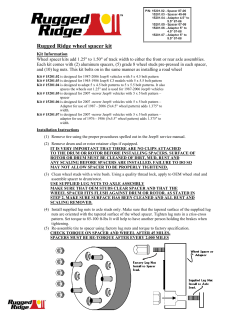
Asthma Child MDI Using
Using a Spacer If you use a metered dose inhaler (MDI), a spacer will help get the correct dose of medication into your lungs. Ask your doctor about a spacer. If you don’t already have one, you need one. Spacers increase your medication’s effectiveness by up to 50%. Cleaning your MDI All MDIs (Metered Dose Inhalers) need to be washed weekly. Here is how to wash and dry an MDI. 1 remove the plastic mouthpiece cap 2 remove the metal canister (don’t put it in water) 1 shake the inhaler well (holding it upright) 3 2 fit the inhaler into the opening at the end of the spacer rinse the mouthpiece and cap under warm water for at least 30 seconds 4 seal lips firmly around the mouth piece -- press the inhaler once only shake off any excess water and dry the mouthpiece and cap thoroughly 5 put the metal canister back in, and replace cap. 3 4 take 1–6 slow breaths in and out through your mouth. Do not remove the spacer from your mouth between breaths. -- remove the spacer from your mouth 5 repeat steps 1-4 for further doses. Child Asthma Plan See your doctor for an influenza vaccination every March Check the manufacturers’ instructions for any special instructions for your type of inhaler. 1 2 1 This Asthma Action Plan belongs to: 3 2 4 5 3 Wash your spacer once a week with warm water and dishwashing liquid. DO NOT RINSE. DRIP DRY to ensure that your medicine gets into your lungs and doesn’t stick to the sides of the spacer. Updated june 2012 Name: Asthma symptoms • there is no cough or wheeze • play or behaviour is the same as other children • reliever inhaler is used less than 3 times per week Worse / Plan to be reviewed when treatment changed Doctors Signature: What to do Preventer Reliever Symptom controller Exercise management Alerts puffs morning and night every day puffs as needed puffs morning and night every day puffs 5 – 10 minutes before exercise Use preventer and symptom controller inhalers, if prescribed every day even when well If reliever is used regularly more than 3 times per week see your doctor Always use a spacer Emergency Reliever Asthma is getting worse when: Worried / • child is getting a cold • occasional cough or wheeze at night • cough or wheeze when child is excited or playing • needing reliever inhaler to control asthma symptoms Continue to use your preventer/symptom controller every morning and night. If not improving within 4 hours of taking reliever inhaler or symptoms worsen move to worried zone Plus take your reliever inhaler. If no better after 1-2 days see your doctor: Phone: However, If not improving within one hour of taking reliever inhaler move to Emergency zone Asthma is worrying when child is working hard to breathe: Take 6 puffs of emergency reliever inhaler via a spacer – child to take 6 breaths for each puff • breathing is faster than usual • “sucking in” around ribs/throat (tip: remove clothing and LOOK at chest/tummy) • change in normal behaviour e.g. tired, miserable, irritable, quiet • if needed more than every four hours see a doctor today • if needed more than every two hours see a doctor now Other instructions: Emergency Well Asthma is well controlled when: Date Prepared: Dial 111 for an ambulance when: • reliever is not working • child is finding it hard to speak, cry or feed • child is blue or pale • parent or child is frightened While waiting for the ambulance: Keep child calm and sitting upright Give 1 puff of emergency reliever: via a spacer — child to take 6 breaths for each puff. Repeat 6 times. Repeat every 6 minutes until ambulance arrives.
© Copyright 2025





















